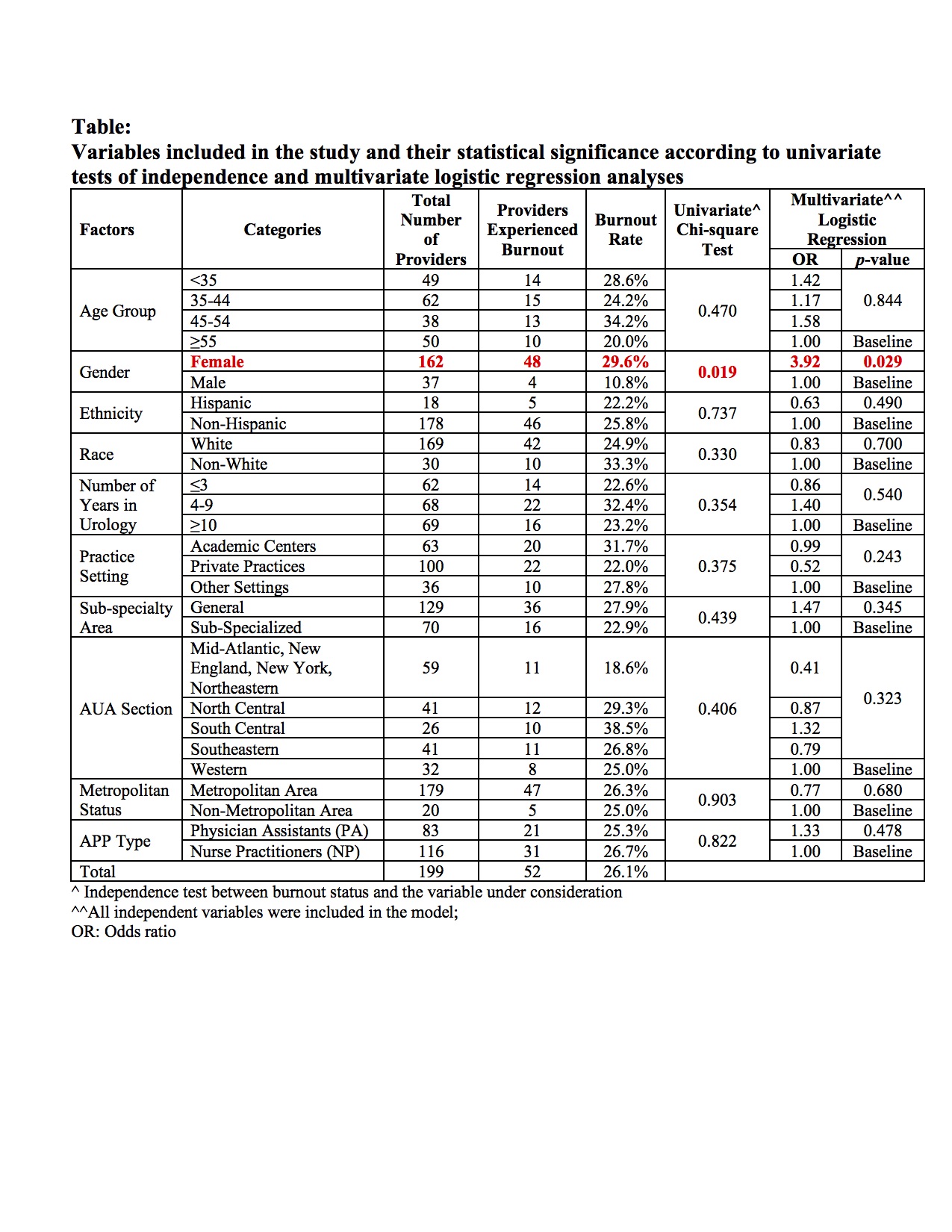Back
Poster, Podium & Video Sessions
Moderated Poster
MP13: Health Services Research: Practice Patterns, Quality of Life and Shared Decision Making I
MP13-07: Professional Burnout of Advanced Practice Providers based on AUA Census Data
Friday, May 13, 2022
2:45 PM – 4:00 PM
Location: Room 228
Kavita Gupta*, Justin Loloi, Bronx, NY, Raymond Fang, Linthicum, MD, Amanda North, Bronx, NY, William Meeks, Linthicum, MD

Kavita Gupta, MD
Resident
Poster Presenter(s)
Introduction: Professional burnout has been recognized as an occupational hazard among health care professionals. The objective of this study was to assess the extent and pattern of burnout in advanced practice providers (APPs) in urology by analyzing the specific American Urological Association (AUA) Census data collected from the APPs. Findings from this study can help maintain a healthy APP workforce and ultimately build a more productive multidisciplinary team, which will help address urologist shortages in the future.
Methods: The AUA conducts an annual Census survey to all providers in the urologic care community including APPs. In the 2019 Census, the widely used Maslach Burnout Inventory (MBI) questionnaire was included to measure burnout among APPs. Data collected included demographics, geographic location, number of years of practice in urology, primary practice setting, primary sub-specialty area, medical team support, clinical responsibilities and professional burnout. Both descriptive and multivariate regression analyses were conducted using IBM-SPSS 27.0.
Results: 199 unique APPs [(83 physician assistants (PAs) and 116 nurse practitioners (NPs)] completed the 2019 Census. Slightly more than one in four APPs experienced professional burnout (25.3% in PAs and 26.7% in NPs). Regarding the key elements of professional burnout, low percentages of APPs reported high levels of emotional exhaustion (13.1%) and depersonalization (23.1%). Observed higher burnout rates were seen in APPs who were aged 45 to 54 (34.3%), women (29.6% vs 10.8% in men, p-value <0.05), non-white (33.3%), 4-9 years of practice in urology and those who practiced in academic medical centers (31.7%). Except for gender, none of the above observed differences were statistically significant. Using a multivariate logistic regression model, gender remained the only significant factor associated with burnout (women vs men with an odds ratio of 3.2 [95% confidence interval (CI): 1.1-9.6].
Conclusions: Exploring professional burnout is important in improving team productivity and wellness. Overall, APPs reported low levels of burnout; however, there was a higher chance of female APPs experiencing professional burnout in comparison to their male counterparts. Future studies are needed to investigate possible reasons for this finding.
Source of Funding: none

Methods: The AUA conducts an annual Census survey to all providers in the urologic care community including APPs. In the 2019 Census, the widely used Maslach Burnout Inventory (MBI) questionnaire was included to measure burnout among APPs. Data collected included demographics, geographic location, number of years of practice in urology, primary practice setting, primary sub-specialty area, medical team support, clinical responsibilities and professional burnout. Both descriptive and multivariate regression analyses were conducted using IBM-SPSS 27.0.
Results: 199 unique APPs [(83 physician assistants (PAs) and 116 nurse practitioners (NPs)] completed the 2019 Census. Slightly more than one in four APPs experienced professional burnout (25.3% in PAs and 26.7% in NPs). Regarding the key elements of professional burnout, low percentages of APPs reported high levels of emotional exhaustion (13.1%) and depersonalization (23.1%). Observed higher burnout rates were seen in APPs who were aged 45 to 54 (34.3%), women (29.6% vs 10.8% in men, p-value <0.05), non-white (33.3%), 4-9 years of practice in urology and those who practiced in academic medical centers (31.7%). Except for gender, none of the above observed differences were statistically significant. Using a multivariate logistic regression model, gender remained the only significant factor associated with burnout (women vs men with an odds ratio of 3.2 [95% confidence interval (CI): 1.1-9.6].
Conclusions: Exploring professional burnout is important in improving team productivity and wellness. Overall, APPs reported low levels of burnout; however, there was a higher chance of female APPs experiencing professional burnout in comparison to their male counterparts. Future studies are needed to investigate possible reasons for this finding.
Source of Funding: none


.jpg)
.jpg)